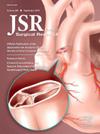Association Between Inadequate Pain Control and Emergency Department Utilization in Trauma Patients
IF 1.8
3区 医学
Q2 SURGERY
引用次数: 0
Abstract
Introduction
Up to 20% of trauma patients return to the emergency department (ED) within 30 d, most commonly for pain. The association between inpatient opioids, discharge prescriptions, and ED visits has not been studied.
Materials and methods
This is a single-institution, retrospective nested case-control study of adult trauma patients admitted to an urban level I trauma center, 2018-2021, with an opioid requirement at discharge. Multivariable logistic regression was used to determine the association between discharge opioid prescriptions, days of pain control prescribed based on individual patient needs, and ED visits for pain.
Results
Of 1569 patients, 1173 (74.76%) were prescribed opioids at discharge, and 167 (10.64%) had an ED visit for pain. Those discharged with an opioid prescription had lower odds of ED visits for pain (odds ratio 0.66, 95% confidence interval 0.44-0.99, P = 0.04). The median days of pain control prescribed at discharge was 0.61 (interquartile range 0-2.22) for those with an ED visit, compared to 1.5 (interquartile range 0.10-3.75) for those without. However, discharge with greater pain control days was not significantly associated the odds of ED visits for uncontrolled pain (odds ratio 0.96, 95% confidence interval 0.91-1.02, P = 0.19).
Conclusions
Among patients requiring opioids at discharge, lack of discharge opioid prescriptions is associated with increased odds of ED visits for pain. For those patients who are prescribed opioids, quantity is not significant, indicating that a conservative approach may be appropriate. Providers should consider careful analysis of inpatient pain control prescriptions, appropriate tapers, and ensure commensurate prescriptions at discharge to optimize pain management and potentially reduce preventable ED visits.
创伤患者疼痛控制不足与急诊科使用率的关系
高达20%的创伤患者在30天内回到急诊科(ED),最常见的是疼痛。住院阿片类药物、出院处方和急诊科就诊之间的关系尚未得到研究。材料和方法这是一项单机构、回顾性巢式病例对照研究,研究对象是2018-2021年在城市一级创伤中心住院的成人创伤患者,出院时需要阿片类药物。使用多变量logistic回归来确定出院阿片类药物处方、基于个体患者需求的疼痛控制天数和因疼痛就诊之间的关系。结果1569例患者中,1173例(74.76%)出院时服用阿片类药物,167例(10.64%)因疼痛就诊于急诊科。服用阿片类药物出院的患者因疼痛而去急诊室就诊的几率较低(优势比0.66,95%可信区间0.44-0.99,P = 0.04)。有急诊科就诊的患者出院时疼痛控制的中位天数为0.61天(四分位数范围0-2.22),而没有急诊科就诊的患者为1.5天(四分位数范围0.10-3.75)。然而,出院时疼痛控制天数越长,因疼痛未控制而去急诊科就诊的几率并不显著相关(优势比0.96,95%可信区间0.91-1.02,P = 0.19)。结论:在出院时需要阿片类药物的患者中,缺乏出院阿片类药物处方与因疼痛而就诊的几率增加有关。对于那些处方阿片类药物的患者,数量并不显著,表明保守方法可能是合适的。提供者应考虑仔细分析住院患者的疼痛控制处方,适当减少,并确保出院时相应的处方,以优化疼痛管理,并可能减少可预防的急诊科就诊。
本文章由计算机程序翻译,如有差异,请以英文原文为准。
求助全文
约1分钟内获得全文
求助全文
来源期刊
CiteScore
3.90
自引率
4.50%
发文量
627
审稿时长
138 days
期刊介绍:
The Journal of Surgical Research: Clinical and Laboratory Investigation publishes original articles concerned with clinical and laboratory investigations relevant to surgical practice and teaching. The journal emphasizes reports of clinical investigations or fundamental research bearing directly on surgical management that will be of general interest to a broad range of surgeons and surgical researchers. The articles presented need not have been the products of surgeons or of surgical laboratories.
The Journal of Surgical Research also features review articles and special articles relating to educational, research, or social issues of interest to the academic surgical community.

 求助内容:
求助内容: 应助结果提醒方式:
应助结果提醒方式:


